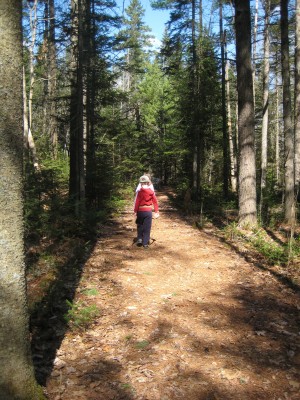Last Child in the Woods ~ Free Play and Fear
I had requested the book Last Child in the Woods by Richard Louv from interlibrary loan, and then I saw that Nicole from Journey to Excellence was going to host a book study. How perfect! Today I’ll be sharing my thoughts while reading the first four chapters. Be sure to click over and visit Nicole to read her comments.

While reading the beginning of the book I was flooded with my childhood memories growing up in a very rural area on old potato farmland. In warm weather I was running around exploring in the woods, rolling down grassy hills, and visiting the frog pond. In winter I was sledding and building forts until my hands were blue. I remember very little of toys I had, but I can replay the sights and smells of the fields and woods in my mind.
After reminiscing my thoughts turned to the way my children are experiencing nature, and I am struck with a difference between my experiences and those of my children. I agree wholeheartedly with much of the author’s discussion of these generational differences, and how much less children are experiencing nature directly now. We are fortunate not to struggle as much with some of the impediments: homeschooling does give us more unstructured time, and we live in Maine with lots of access to natural areas. In Chapter 3 when the author quoted a British study that kids could identify Pokemon characters better than native plant species I gave myself a little pat on the back for incorporating nature study into our homeschool fairly regularly over the last year, and determined to work it in even more in the coming years.
After the pat on the back I felt not so proud in one area: free play in nature. With homeschooling I looked forward to giving my children more time to enjoy time outside, but truthfully free play has not happened as much as I would like. We do walk or ride bikes most days (thanks to our dog), but free play in nature is not as big a part of their lives as it should be. Often I’m with them and tend to be still directing things. I was especially interested the discussions in Chapter 4 on the type of outside environment, and how there does seem to be a difference between outdoor play on a structured playground versus a more unstructured natural setting. This is one area that is difficult because we live on a small lot in a relatively new subdivision with mostly lawns and gardens and no wooded areas. I’m afraid there isn’t as much nature to fuel the imagination in our backyard as there is in a less manicured area. I have to take them to more natural places, and when I do our time is limited by me wanting to get back home to my lengthy to-do list. I don’t want my responsibilities as an adult to shorten their time to be kids and experience the same play time I had as a child, but it really is difficult.
Other than my feeling the need to be home to get things done, the other barriers to unstructured time in nature for my children is my fear. I have a hard time if they’re playing where I can’t see them. I fear they’ll get hurt and I won’t be there to either prevent it or help when it happens. Add to that a fear I am especially struggling with this summer: ticks. I have had ticks on me recently, and I have a friend recently diagnosed with Lyme disease. I hate to douse ourselves with chemicals in order to spend a little time in the woods, but reading the many benefits in this book may push me to try getting out in the woods more, even if a hefty dose of DEET has to go with us.
As I read Chapter 4 about nature’s healing properties, I remembered during my teen years taking walks in an old farm field across the road. Once I walked out into it and over the hill, I couldn’t see a single house. It was just me and the wind and the wildflowers. It was so calming and a great time to think. I have seen days in our homeschool that just are not going well and time outside (especially in the woods) has saved the day. I am determined to use nature more to benefit both myself and my children.
I’m very excited to continue reading this book. It reminds me a bit of my feelings when reading The Read-Aloud Handbook by Jim Trelease. I already read a lot to my children, but that book reinforced for me the many benefits of it and assures that time for read-aloud will not be the first thing we cut if we’re low on time. I have a feeling time in nature will also be higher on my priority scale after finishing this book.
 Hi, I'm Heidi and I homeschool my two sweet kids. I want them to know that learning is an exciting lifelong adventure! We love great books, unit studies, notebooking, lapbooking, and hands-on learning.
Hi, I'm Heidi and I homeschool my two sweet kids. I want them to know that learning is an exciting lifelong adventure! We love great books, unit studies, notebooking, lapbooking, and hands-on learning.



